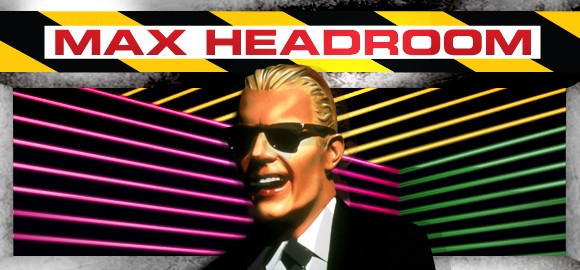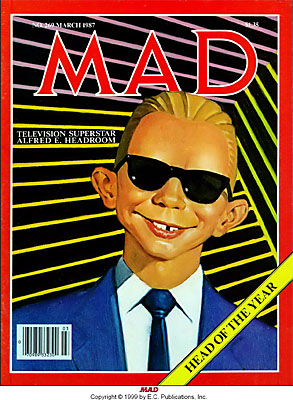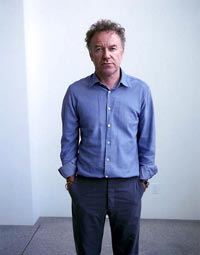
For this week’s “Things That Bring Back Memories” post, I am going to pick something in the topic of “TELEVISION” and go with “Max Headroom“. This was more a commercial character that later was made into a television show (which I didn’t really care for personally), but the commercials, and a music video that he did were always ones that we loved!
Being one that grew up in the 80’s, seeing something that was computer generated was like a big deal – crazy to find out now, that it was just the background that was!! Who remembers the Dire Straits “Money for Nothing” video? Seeing something like that at the age where cartoons are a bit too lame, but other stuff just isn’t your style, we loved it!! For those of you, who are either too young, or just don’t remember it, here’s a video of some of the best bits, and the reason that we enjoyed watching “Max Headroom” so much:
So, did you ever watch these commercials, or see the show when you were younger? or have you seen it on TV or the internet later in life? Let me know what you thought of it, and if you have any memories of it in your life!
More Info on the Character:
Max Headroom is a fictional British artificial intelligence (AI), known for his wit and stuttering, distorted, electronically sampled voice. He was introduced in early 1984. The character was created by George Stone, Annabel Jankel and Rocky Morton in the mid-1980’s, and portrayed by Matt Frewer as “The World’s first computer-generated TV host,” although the computer-generated appearance was achieved with prosthetic make up and  hand-drawn backgrounds, as the computer technology of the time was not sufficiently advanced to achieve the desired effect. Preparing the look for filming involved a four-and-a-half hour session in make-up, which Frewer described as “grueling” and “not fun,” likening it to “being on the inside of a giant tennis ball.
hand-drawn backgrounds, as the computer technology of the time was not sufficiently advanced to achieve the desired effect. Preparing the look for filming involved a four-and-a-half hour session in make-up, which Frewer described as “grueling” and “not fun,” likening it to “being on the inside of a giant tennis ball.
The classic look for the character was a shiny dark suit—which was actually a fibreglass mould—often paired with Ray-Ban Wayfarer sunglasses. Only his head and shoulders were depicted, usually against a “computer-generated” backdrop of a slowly rotating wire-frame cube interior, which was also initially generated by analogue means—in this case traditional cel animation, though later actual computer graphics were employed for the backdrop. Another distinguishing trademark of Max was his chaotic speech patterns—his voice would pitch up or down seemingly at random, or occasionally get stuck in a loop. These modulations, achieved with a harmonizer, also appeared when the character was performed live.
The character’s personality was partly intended as a satire of insincere and egotistical television personalities—what Rocky Morton described as the “very sterile, arrogant, Western personification of the middle-class, male TV host,” but also was “media-wise and gleefully disrespectful” which appealed to young viewers.
Matt Frewer was chosen for his ability to improvise, and his—according to producer Peter Wagg—”ideally exportable” Mid-Atlantic accent. The actor decided to model Max’s personality after what he saw as the smarmy, self-important goofiness of The Mary Tyler Moore Show’s Ted Baxter. In a 1986 interview, Frewer said: “I particularly wanted to get that phony bonhomie of Baxter … Max always assumes a decade long friendship on the first meeting. At first sight he’ll ask about that blackhead on your nose.”
The background story provided for the Max Headroom character in his original appearance comes from a dystopian near-future dominated by television and large corporations. The AI of Max Headroom was shown to have been created from the memories of crusading journalist Edison Carter. The character’s name came from the last thing Carter saw during a vehicular accident that put him into a coma — a warning sign marked “MAX. HEADROOM: 2.3 M” (i.e., a clearance of 2.3 meters) suspended across a car park entrance.
 Movie: Max Headroom originally appeared in the British-made cyberpunk TV movie Max Headroom: 20 Minutes into The Future which was broadcast in 1985. The original movie was rebroadcast on More4 on 21 October 2007 as part of the 25th birthday celebrations of Channel 4.
Movie: Max Headroom originally appeared in the British-made cyberpunk TV movie Max Headroom: 20 Minutes into The Future which was broadcast in 1985. The original movie was rebroadcast on More4 on 21 October 2007 as part of the 25th birthday celebrations of Channel 4.
Television Show: After its success, the titular character was spun off into a veejay in the British music video program, The Max Headroom Show, whose first episodes unusually featured no introductory title sequence or end credits. The spin-off show was an immediate cult hit, doubling Channel 4’s viewing figures for its slot. A second season, which broadened the original concept to include celebrity interviews and a studio audience, was produced in late 1985, and a third and final season ran in 1986 (The second and third seasons were shown first on the US cable channel Cinemax, and on Channel Four an average of six months later). A Christmas special was produced at the end of the second season and seen by UK audiences just before the regular run of the season, and just after the US season concluded. Cinemax produced a fourth season of the talk show on its own, The Original Talking Max Headroom Show, which ran for six episodes in 1987. These episodes were never shown in the UK.
Series: The final spin-off from the original film was the dramatic television series, Max Headroom, which was broadcast in the United States, running for two short seasons (Spring 1987 and Fall 1987), with two more episodes shown later in 1988. Shout! Factory released Max Headroom: The Complete Series on DVD in the United States and Canada on August 10, 2010.
Other appearances: New Coke Max Headroom – Max became a celebrity outside the television series. He was the spokesman for New Coke (after the return of Coca-Cola Classic), delivering the slogan “Catch the wave!” (in his trademark staccato, stuttering playback as “Ca-ca-ca-ca-ca-catch the wave!”). In the UK, Max appeared in television commercials for Radio Rentals. He also hosted an interview show on the Cinemax cable channel, called The Original Max Talking Headroom Show. In 1987, Frewer appeared as Max Headroom in a segment for Sesame Street. He recites the alphabet with selected commentary on some of the letters. On November 22, 1987, an unidentified hijacker used Max as a basis for a hijack in the Max Headroom broadcast signal intrusion. An older-looking Max was used in a campaign to inform UK households of the impending digital TV switch over. As he is looked after by a caretaker, he moans about being with the other “relics”, and then talks about digital TV. He stated that Channel 4 is now suddenly “20 years into the future”, making a subtle reference to 20 Minutes into the Future. Max makes a cameo appearance in the 2015 movie Pixels.
Some of the Creators:
George Stone is Max Headroom’s creator in almost every respect. A marketing executive and science fiction writer who worked for Chrysalis Productions, he was tasked by Wagg, Morton and Jankel to write the overall back story of this new creation. A vast number of details of Max, his genesis and his world came from Stone’s original draft. However, the overall story and setting was considered too complex to film for the small screen, so many elements were eliminated or toned down for the telefilm script. I had the great pleasure of meeting George a few years ago in London, and he’s everything you’d think the creator of something as bizarre and wonderful as Max Headroom might be. He appears in a couple of the more recent retrospectives and documentaries.
 Annabel Jankel was born June 1, 1955, and is an English film and TV director who first came to prominence as a music video director and the co-creator and director of the pioneering cyber-character Max Headroom. She is the sister of musician and songwriter Chaz Jankel, who is best known as a member of new wave band Ian Dury & The Blockheads. She started her career in the late 1970’s at the UK-based film production company Cucumber Studios which she founded with her partner – fellow director Rocky Morton. Jankel and Morton specialized in creating music videos, TV commercials and TV title sequences using a combination of live action, animation and the then emerging art of computer graphics. In this period the duo directed several music videos for performers including Elvis Costello (“Accidents Will Happen”), Talking Heads (“Blind”), Tom Tom Club (“Genius of Love”, “Pleasure of Love”, “Don’t Say No”), Donald Fagen (“New Frontier”) and Miles Davis (“Decoy”). In 1985, Jankel and Morton won an Emmy Award for their title sequence for the NBC show Friday Night Videos. In 2003, their 1978 music video for Elvis Costello’s “Accidents Will Happen” was one of only 35 videos selected for inclusion in the Museum of Modern Art’s prestigious “Golden Oldies Of Music Video” exhibition. Their music videos are found in the permanent collections of the Museum of Modern Art in New York and at the Victoria & Albert Museum in London. In 1984, Jankel and Morton co-authored a book titled Creative Computer Graphics that detailed the history of the craft and essayed its future. Jankel and Morton created and directed “The Enemy Within” music video for the Canadian trio Rush.
Annabel Jankel was born June 1, 1955, and is an English film and TV director who first came to prominence as a music video director and the co-creator and director of the pioneering cyber-character Max Headroom. She is the sister of musician and songwriter Chaz Jankel, who is best known as a member of new wave band Ian Dury & The Blockheads. She started her career in the late 1970’s at the UK-based film production company Cucumber Studios which she founded with her partner – fellow director Rocky Morton. Jankel and Morton specialized in creating music videos, TV commercials and TV title sequences using a combination of live action, animation and the then emerging art of computer graphics. In this period the duo directed several music videos for performers including Elvis Costello (“Accidents Will Happen”), Talking Heads (“Blind”), Tom Tom Club (“Genius of Love”, “Pleasure of Love”, “Don’t Say No”), Donald Fagen (“New Frontier”) and Miles Davis (“Decoy”). In 1985, Jankel and Morton won an Emmy Award for their title sequence for the NBC show Friday Night Videos. In 2003, their 1978 music video for Elvis Costello’s “Accidents Will Happen” was one of only 35 videos selected for inclusion in the Museum of Modern Art’s prestigious “Golden Oldies Of Music Video” exhibition. Their music videos are found in the permanent collections of the Museum of Modern Art in New York and at the Victoria & Albert Museum in London. In 1984, Jankel and Morton co-authored a book titled Creative Computer Graphics that detailed the history of the craft and essayed its future. Jankel and Morton created and directed “The Enemy Within” music video for the Canadian trio Rush.
 Rocky Morton was born in 1955, and is an English director. He was one of the co-creators of Max Headroom and co-director on Super Mario Bros.. Various music videos by Rush, Tom Tom Club, Talking Heads, Led Zeppelin, Cathy Dennis, Gravity Kills, Orgy and Miles Davis are credited to Morton. He also directed the 1995 UK launch commercial of Sega Saturn, entitled Finishing Touch. Alongside his partner, Annabel Jankel, the duo made their television debut with the original Max Headroom: 20 Minutes into the Future, and its Americanized version. The duo made their big-screen debut with the remake of the film noir classic, D. O. A., starring Dennis Quaid and Meg Ryan.
Rocky Morton was born in 1955, and is an English director. He was one of the co-creators of Max Headroom and co-director on Super Mario Bros.. Various music videos by Rush, Tom Tom Club, Talking Heads, Led Zeppelin, Cathy Dennis, Gravity Kills, Orgy and Miles Davis are credited to Morton. He also directed the 1995 UK launch commercial of Sega Saturn, entitled Finishing Touch. Alongside his partner, Annabel Jankel, the duo made their television debut with the original Max Headroom: 20 Minutes into the Future, and its Americanized version. The duo made their big-screen debut with the remake of the film noir classic, D. O. A., starring Dennis Quaid and Meg Ryan.
Did You Know?
The newsman played by Ted Knight on The Mary Tyler Moore Show was what actor Matt Frewer was shooting for. “I particularly wanted to get that phony bonhomie of Baxter … Max always assumes a decade long friendship on the first meeting. At first sight he’ll ask about that blackhead on your nose.” What a victory it must have been when, as a guest on Max’s 1987 talk show, Mary Tyler Moore herself told the host “You remind me of a young Ted Baxter.”
He had already been seen in commercials for New Coke, and had a show airing on Cinemax, but before he showed up on his own series on ABC, he appeared as a guest on NBC’s Late Night With David Letterman. According to Dave, this was his “American network television debut.”
Even if you do know a few of the things in this list of things you supposedly don’t know, this is one you definitely don’t know. Nobody does. This is a hacker interrupting a broadcast of Doctor Who on a Chicago PBS station on November 22, 1987. To this day, the culprit has not been identified.
In late 1987, following the cancellation of the American TV series, it was announced that a feature film titled Max Headroom for President would be produced. Frewer, quoted in a Marilyn Beck column in December 1987, indicated the plan was for the film, which at that point had no finalized script, to be shot in early 1988 in order to capitalize on the 1988 United States presidential election. The film was never made, possibly due to the 1988 Writers Guild of America strike which erupted three months later.
Mr. Belvedere (1985) was picked to replace Max Headroom (1987) after it was canceled and Mr. Belvedere (1985) was planned to be short lived also. 88 episodes were added to its original cancellation date was postponed.
The image of Max was not computer generated but Matt in a complicated makeup prosthesis then superimposed using blue screen technology. The ticks were created by repeating a singe frame a few times occasionally.
Thanks for stopping by today. Please be sure to leave a comment, if this show meant something to you, too. Or to just let me know what you think of the story in this post! TigerStrypes claims no credit for any images used on this post, unless otherwise noted. Images in this post are copyright to their respectful owners. If there is an image appearing on this blog that belongs to you and do not wish for it appear on this site, please email us with a link to said image and it will be promptly removed. Thanks and have a great day!!



Oh, wow! And the memories come a flooding back! LOL I hadn’t thought about Max Headroom in a along time. Thanks for the smile.
~Lorelai
Life With Lorelai
I grew up in the 80’s also, so I genuinely enjoyed this post! Thanks for sharing! Loving co-hosting with you!
You’re welcome, Michelle – thanks for stopping by. I figure that in the days before Google, a lot of people might have forgot about these, or never knew of them. 🙂
I was in my 30’s when Max made his debut-and although I heard about him I never did see any of the commercials. All of this was very interesting and I enjoyed reading about the time line this character took.
He was one that not many knew about, that’s why I wanted to share. 🙂
Oh wow, I remember this! We must be about the same age since so many of your memories posts are so familiar to me!!
Finally, someone remembers!! 1975 over here! 🙂
Dont remember this one. Was this during MTV days?
Max was known for some Diet Coke commercials and yes, during the MTV days…when they actually did still play music! 🙂
Oh wow, I don’t think I’ve ever heard of Max. Looks like an interesting character!
I wondered if anyone had heard of him before. It was a funny one back in the day!